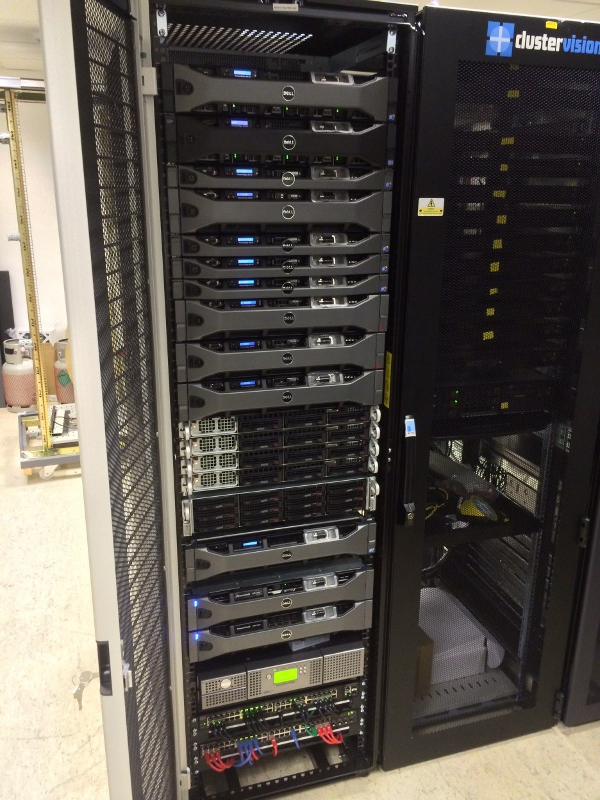Difference between revisions of "Bert and Ernie - An Overview"
(→What is HPC?) |
Ibers-admin (talk | contribs) |
||
| Line 11: | Line 11: | ||
The combined compute capacity is as follows; | The combined compute capacity is as follows; | ||
| − | We have | + | We have 544 CPU cores, 4.2TB RAM and 43TB storage capacity and 11TB of fast access disk. This is backed by a 1/4 PB storage array for storage of sequencing data. |
Specs Per node; | Specs Per node; | ||
| Line 19: | Line 19: | ||
512GB RAM | 512GB RAM | ||
| − | node002 ( | + | node002 (fat.q) - 16 Cores |
| − | Intel(R) Xeon(R) CPU | + | Intel(R) Xeon(R) CPU E5-2620 v4 @ 2.1GHz |
| − | + | 1024GB RAM | |
node003 (intel.q) - 8 Cores | node003 (intel.q) - 8 Cores | ||
Revision as of 13:03, 15 March 2017
What is HPC?
Scientific computing generally revolves around researchers performing complex calculations as fast as possible. The super computers of the 70s, 80s and 90s were custom built to provide researchers with access to a machine with more memory (RAM) and CPU cores than the small, slow and expensive desktop computers of the era. These large machines such as those build by Cray and SGI were expensive and took a huge amount of space, power and cooling.
In the early 2000s, the first multi core processors were released which dramatically changed the ability for users to being to take advantage of parallelisation when performing calculations. Today, the term High Performance Computing (HPC) is used to describe a form of supercomputing based upon off the shelf hardware. HPC clusters are often built from the same hardware as that which is found in high-end desktop workstations or web servers.
The IBERS HPC
Names Bert and Ernie, the IBERS HPC built by ClusterVision consists of a master node (ernie), a login node (bert), 11 compute nodes, two storage nodes.
The combined compute capacity is as follows;
We have 544 CPU cores, 4.2TB RAM and 43TB storage capacity and 11TB of fast access disk. This is backed by a 1/4 PB storage array for storage of sequencing data.
Specs Per node;
node001 (large.q) - 32 Cores 4 x AMD Opteron(TM) Processor 6220 512GB RAM
node002 (fat.q) - 16 Cores Intel(R) Xeon(R) CPU E5-2620 v4 @ 2.1GHz 1024GB RAM
node003 (intel.q) - 8 Cores Intel(R) Xeon(R) CPU X5647 @ 2.93GHz 192GB RAM
node004 (intel.q) - 8 Cores Intel(R) Xeon(R) CPU X5647 @ 2.93GHz 192GB RAM
node005 (amd.q) - 32 Cores 4 x AMD Opteron(TM) Processor 6220 98GB RAM
node006 (amd.q) - 32 Cores 4 x AMD Opteron(TM) Processor 6220 98GB RAM
node007 (amd.q) - 32 Cores 4 x AMD Opteron(TM) Processor 6220 98GB RAM
node008 (amd.q) - 64 Cores 4 x AMD Opteron(tm) Processor 6376 256GB RAM
node009 (amd.q) - 64 Cores 4 x AMD Opteron(tm) Processor 6376 256GB RAM
node010 (amd.q) - 64 Cores 4 x AMD Opteron(tm) Processor 6376 256GB RAM
node011 (amd.q) - 64 Cores 4 x AMD Opteron(tm) Processor 6376 256GB RAM
node012 (large.q) - 64 Cores 4 x AMD Opteron(tm) Processor 6376 512GB RAM
node013 (metabolomics.q) - 64 Cores 4 x AMD Opteron(tm) Processor 6376 512GB RAM
